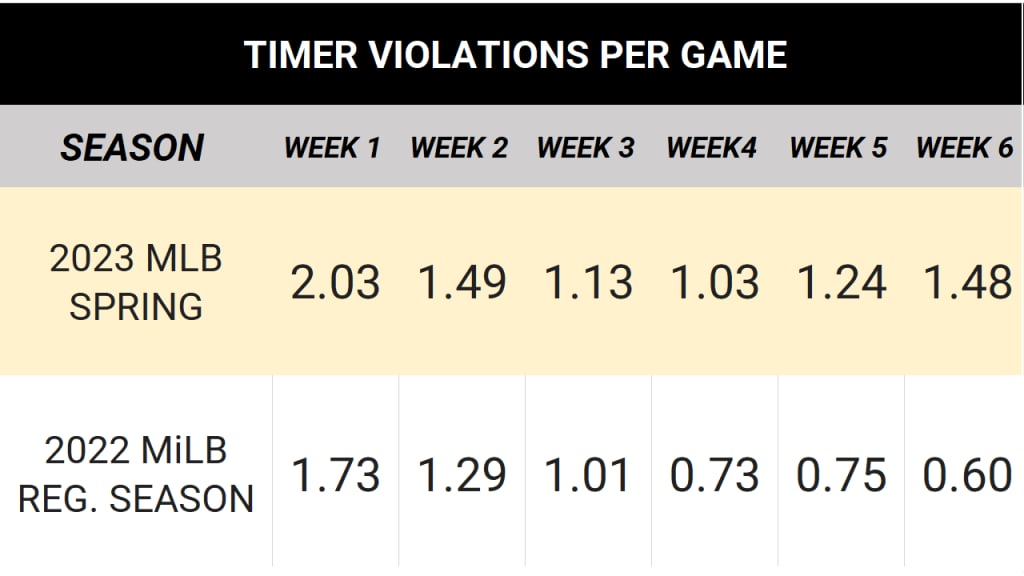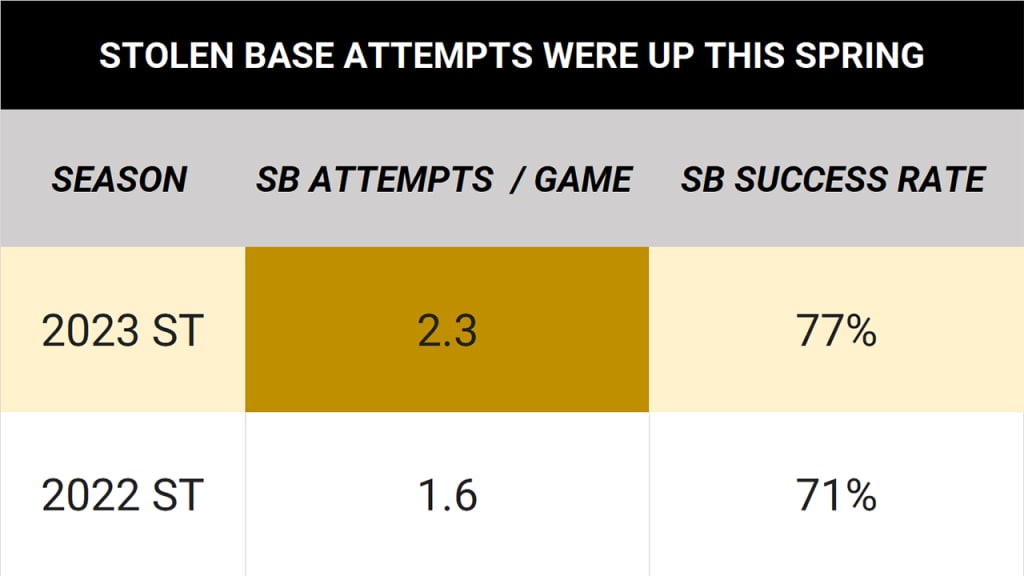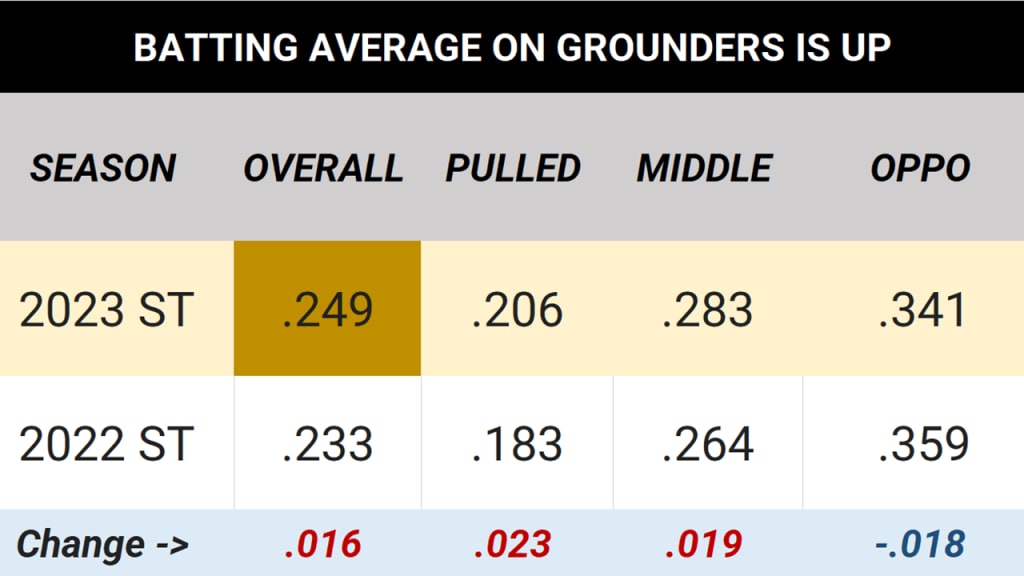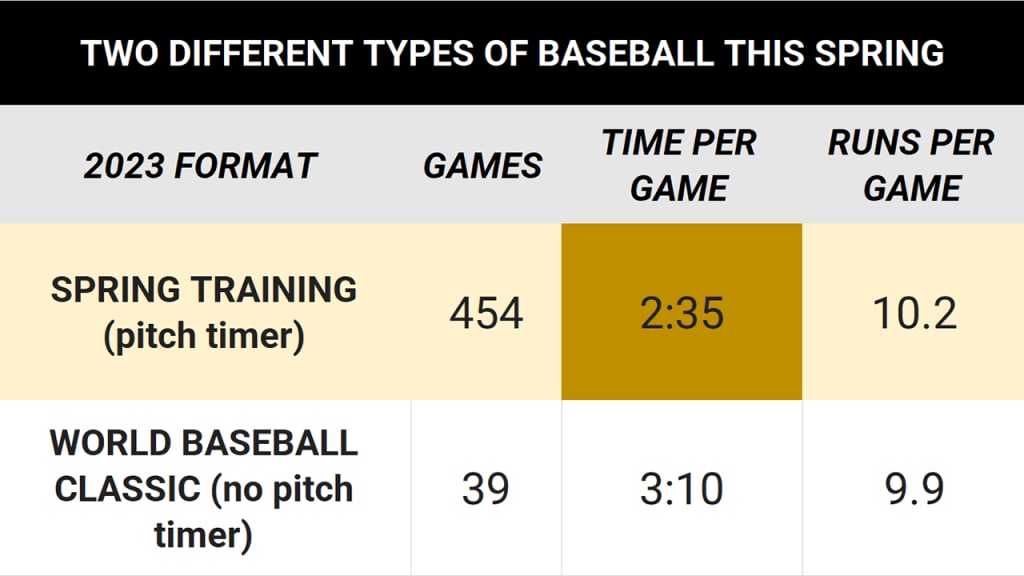We know not to take Spring Training numbers all that seriously. The Cardinals, for instance, will not be staging a parade to celebrate having the best record of the exhibition season.
But the numbers from the Grapefruit and Cactus Leagues are quite a bit more important when they relate to the major rule changes MLB has adopted for the 2023 season. Like your favorite player’s exhibition batting average, these numbers are not ironclad. But they do give us a window into how the pitch timer, defensive shift restrictions and bigger bases are going to impact Major League play this year.
So let’s run through five things we saw with regard to the rules in the spring season and the numbers behind them.
1. We saw -- again -- that the pitch timer works.
The pitch timer was created to cure the problem of dead time, and, in the exhibition season -- as in last year’s Minor League trial -- it did precisely that.
Compared to Spring Training games last year, the average nine-inning game time was cut by 26 minutes from both 2022 and '21.

Note: The average nine-inning game time in the 2022 regular season was 3:03
The pitch timer acted much the same way it did in MiLB last year, when the average nine-inning game time was reduced by 25 minutes.
And as you can see, that game-time reduction did not mean “less baseball.” The run-scoring environment was in line with recent springs, which is especially notable given how many star hitters left Spring Training for a couple of weeks to compete in the World Baseball Classic. What was reduced was non-baseball -- pitchers pacing around the mound, batters adjusting their gloves, people scratching themselves, etc.
“[The pitch timer] is going to be a good thing for everybody,” Yankees slugger Aaron Judge said. “When they brought the shot clock into basketball all those years ago, they had to learn to adjust. You couldn’t just sit around and dribble and run motion for five minutes.”
Good job, pitch timer. You’re on the Opening Day roster, pal.
2. We saw a reduction in violations as games progressed.
In the Minor Leagues last year, games were played without the pitch timer for the first two weeks of the regular season. Then, the timer arrived, and everybody -- including the umpires -- adjusted on the fly. At season’s end, 90 percent of MiLB players polled said it took them “about a month” to make that adjustment. Pitch-timer infractions went from 1.73 per game in the first week with the clocks to 0.53 per game by the sixth week.
MLB decided to use Spring Training -- not the regular season -- for that adjustment period this year. The umpires were also instructed to be strict with their enforcement of the new rules from Day 1. And sure enough, on the first full day of spring games, we had a game end on an automatic strike with the bases loaded, two out and the count full in the bottom of the ninth.
Strict enforcement, indeed.
But while that enforcement contributed to a higher rate of infractions than what we saw in the first month of Minor League play from 2022, we did generally see violations trend down.

Note: Weeks end with games played on Sundays
3. We saw WAY more stolen-base activity.
It was a given that runners would be more daring on the basepaths now that pitcher pickoffs are limited and the bases are a little bit bigger. But stolen-base attempts per game actually went up more than 40 percent:

To put that in perspective, if we were to see the same percentage increase in attempts in the regular season, it would bring about the highest number of attempts since 1999.
It’s doubtful the increase will be quite as pronounced in the regular season. But the Minor Leagues saw a 26% jump in stolen-base attempts as a result of the new rules, and this spring has given us reason to suspect we could be in for a similar jump in MLB.
"I think it's definitely a friendlier base-stealing environment with the game now," Brewers outfielder Christian Yelich said.
4. We saw a lot more ground balls go for hits.
The primary point of the defensive shift restrictions is to provide more traditional outcomes on balls in play. No more second basemen stationed in right field, in perfect position to scoop up a scorching ground ball that, for roughly 100 years of baseball history, would have been a single.
How much the infield shift ban will impact the batting average bottom line in the Major League season remains to be seen (the Minor League data wasn’t really conclusive). But the spring numbers were eye-catching:

As you can see, the increase was particularly pronounced on pulled ground balls. The overall batting average on balls in play league-wide was .317, up from .311 in Spring Training last year. The league-wide BABIP in the 2022 regular season was just .290.
“I’ve sort of turned the corner on the shift [limits],” Rockies manager Bud Black said. “There’s a part of me that says, from a strategic standpoint, ‘Why should we be told how to play defense?’ But the NBA made changes, right? … It will create what fans want. It’s more defensive plays based on not having a bunch of guys in one spot where a guy hits the ball. So I’m all right with the [limits].”
Another effect of the shift restrictions is that having rangy middle infielders matters again.
“I’m all for being in a position where I can be athletic and move a little bit more and try to make more defensive plays,” Mets shortstop Francisco Lindor said. “I think this is going to put us in a better position to make good plays and crazy plays.”
5. We saw “old rules” that felt … old.
The World Baseball Classic was awesome. The Shohei Ohtani-Mike Trout ending could not have been scripted much better.
But it took a while to get to that ending.
For those locked into the exhibition action, it was amazing how different the pacing of the Classic games -- played without the pitch timer and the other new rules -- felt.
Despite more runs and batters per game, the spring tilts were much more crisp:

Obviously, the Classic games were of much higher stakes and importance, so this is a bit of an apples-to-oranges comparison. But to those within the sport, the difference between the two environments was jarring.
“I left the WBC after the fifth because I was tired and it was two and a half hours in, and that's usually when the game's over here,” Marlins manager Skip Schumaker said after attending Venezuela vs. Puerto Rico. “So I didn't realize it until I actually went to a game after the pitch clock how long those games are. Didn't know if I'd like [the timer] or not. But I actually really like it. I'm a fan of it.”
